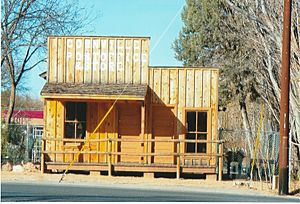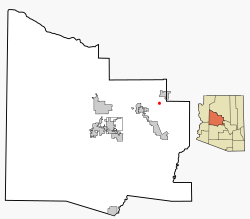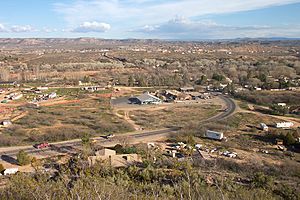Cornville, Arizona facts for kids
Quick facts for kids
Cornville, Arizona
|
|
|---|---|

1909 Cornville Post Office
|
|

Location in Yavapai County and the state of Arizona
|
|
| Country | United States |
| State | Arizona |
| County | Yavapai |
| Area | |
| • Total | 13.97 sq mi (36.19 km2) |
| • Land | 13.97 sq mi (36.19 km2) |
| • Water | 0.00 sq mi (0.00 km2) |
| Elevation | 3,225 ft (983 m) |
| Population
(2020)
|
|
| • Total | 3,362 |
| • Density | 240.59/sq mi (92.89/km2) |
| Time zone | UTC−07:00 (MST) |
| ZIP Code |
86325
|
| Area code(s) | 928 |
| FIPS code | 04-15920 |
| GNIS feature ID | 0027961 |
Cornville is a community in Yavapai County, Arizona, United States. It's known as a "census-designated place" (CDP), which means it's an area defined by the government for counting people. In 2020, about 3,362 people lived there. Cornville includes the smaller areas of Cornville and Page Springs.
Many people who live in Cornville and Page Springs work in nearby towns like Sedona and Cottonwood. Both communities are located along Oak Creek, a stream that flows into the Verde River. The lower part of Oak Creek is a special place for birds, recognized by the National Audubon Society. Page Springs also has a large fish hatchery, which is a farm for raising fish. You can find hiking trails and great spots for bird-watching near the hatchery.
A famous person who lived in Cornville was John McCain. He was a U.S. Senator and ran for president in 2008. His home in Cornville was where he prepared for important debates. He passed away at his home in Cornville in 2018.
Contents
History of Cornville
Early People and Explorers
The area around Cornville was once home to the Sinagua people. They lived there long ago, leaving behind buildings like those at Montezuma Castle National Monument. By the early 1400s, the Sinagua had left the area. Some Hopi clans today believe they are related to the Sinagua.
Later, the Yavapai people lived in the Cornville area. A Spanish explorer named Antonio de Espejo passed through in 1583. The Yavapai were friendly with the Spanish at first. However, later Spanish trips saw more tension with Native American groups, possibly because the Apache and Navajo people had also moved into the region. The Spanish stopped exploring the area because they didn't find valuable minerals and it was far from their other settlements.
Settlers Arrive
By the 1820s, American explorers called "mountain men" started arriving. More settlers came in the 1860s. At this time, the Cornville area was home to both Apache and Yavapai people. In 1875, the U.S. army moved many Yavapai and Apache people to the San Carlos Reservation in eastern Arizona. However, some Apache stayed hidden in the Lower Oak Creek area.
After this, relations between settlers and Native Americans in the Verde Valley became mostly peaceful. Settlers quickly built an irrigation ditch to help their farms on the west side of Oak Creek.
How Cornville Got Its Name
The first settlers in the Lower Oak Creek area were Captain Andrew Jackson and his wife Margaret, who arrived in 1876. Other families soon followed.
There are a couple of ideas about how Cornville got its name. One story says settlers wanted to name it "Cohnville" after a family named Cohn, but the papers from Washington D.C. mistakenly read "Cornville." However, records don't show a Cohn family living there at the time. Another idea is that it was named by James Dunning Tewksbury, an early settler who was born in Cornville, Maine.
The Cornville post office opened on May 11, 1887. Samuel Dickinson was the first postmaster. For many years, Cornville was mostly a farming community. Some people also worked in mines in nearby towns like Jerome and Cottonwood. Starting in the late 1960s, more retirees and people who worked in other towns began to move to Cornville.
In 1995, a new community called Verde Santa Fe was built in Cornville. It's a golf-course community with nearly 1,000 homes.
Geography and Climate
Cornville is located at 34°42′58″N 111°54′36″W / 34.71611°N 111.91000°W. It covers an area of about 13.2 square miles (36.19 square kilometers), all of which is land.
Cornville has a semi-arid climate. This means it's generally dry, but not a true desert.
Population Information
| Historical population | |||
|---|---|---|---|
| Census | Pop. | %± | |
| 1990 | 2,089 | — | |
| 2000 | 3,335 | 59.6% | |
| 2010 | 3,280 | −1.6% | |
| 2020 | 3,362 | 2.5% | |
| U.S. Decennial Census | |||
In 2000, there were 3,335 people living in Cornville. About 28.7% of households had children under 18. The average household had 2.47 people.
The population was spread out, with 24.5% under 18 years old and 13.4% aged 65 or older. The average age was 41 years.
Fun Places to Visit
One unique attraction in Cornville is Eliphante. It's a special village made up of amazing domes and buildings, all built by hand since 1987 by artists Michael Kahn, Leda Livant Kahn, and others. A non-profit group helps take care of Eliphante. If you're a member, you can visit by making an appointment.
Education
Students in Cornville attend schools in the Cottonwood-Oak Creek School District. Oak Creek Elementary School is located right in Cornville.
There is also a private boarding school in Cornville called the Oak Creek Ranch School.
Older students from Cornville go to Mingus Union High School, which is in the nearby town of Cottonwood.
Notable People
- Senator John McCain had a home in Cornville. He passed away there in 2018.
- Maynard James Keenan is a musician known for bands like Tool and A Perfect Circle.
- John Henry Waddell was a sculptor who had a studio in Cornville until he passed away in 2019.
Images for kids
See also
 In Spanish: Cornville (Arizona) para niños
In Spanish: Cornville (Arizona) para niños








